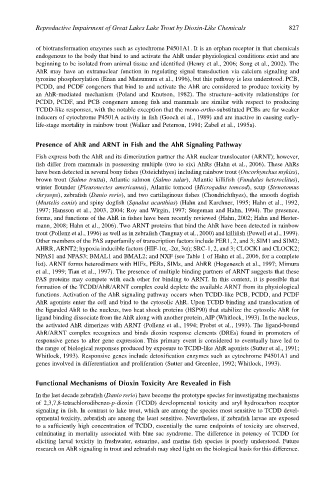Page 847 - The Toxicology of Fishes
P. 847
Reproductive Impairment of Great Lakes Lake Trout by Dioxin-Like Chemicals 827
of biotransformation enzymes such as cytochrome P4501A1. It is an orphan receptor in that chemicals
endogenous to the body that bind to and activate the AhR under physiological conditions exist and are
beginning to be isolated from animal tissue and identified (Henry et al., 2006; Song et al., 2002). The
AhR may have an extranuclear function in regulating signal transduction via calcium signaling and
tyrosine phosphorylation (Enan and Matsumura et al., 1996), but this pathway is less understood. PCB,
PCDD, and PCDF congeners that bind to and activate the AhR are considered to produce toxicity by
an AhR-mediated mechanism (Poland and Knutson, 1982). The structure–activity relationships for
PCDD, PCDF, and PCB congeners among fish and mammals are similar with respect to producing
TCDD-like responses, with the notable exception that the mono-ortho-substituted PCBs are far weaker
inducers of cytochrome P4501A activity in fish (Gooch et al., 1989) and are inactive in causing early-
life-stage mortality in rainbow trout (Walker and Peterson, 1991; Zabel et al., 1995a).
Presence of AhR and ARNT in Fish and the AhR Signaling Pathway
Fish express both the AhR and its dimerization partner the AhR nuclear translocator (ARNT); however,
fish differ from mammals in possessing multiple (two to six) AhRs (Hahn et al., 2006). These AhRs
have been detected in several bony fishes (Osteichthyes) including rainbow trout (Oncorhynchus mykiss),
brown trout (Salmo trutta), Atlantic salmon (Salmo salar), Atlantic killifish (Fundulus heteroclitus),
winter flounder (Pleuronectes americanus), Atlantic tomcod (Microgadus tomcod), scup (Stenotomus
chrysops), zebrafish (Danio rerio), and two cartilaginous fishes (Chondrichthyes), the smooth dogfish
(Mustelis canis) and spiny dogfish (Squalus acanthias) (Hahn and Karchner, 1995; Hahn et al., 1992,
1997; Hansson et al., 2003, 2004; Roy and Wirgin, 1997; Stegeman and Hahn, 1994). The presence,
forms, and functions of the AhR in fishes have been recently reviewed (Hahn, 2002; Hahn and Hester-
mann, 2008; Hahn et al., 2006). Two ARNT proteins that bind the AhR have been detected in rainbow
trout (Pollenz et al., 1996) as well as in zebrafish (Tanguay et al., 2000) and killifish (Powell et al., 1999).
Other members of the PAS superfamily of transcription factors include PER1, 2, and 3; SIM1 and SIM2;
AHRR, ARNT2; hypoxia inducible factors (HIF-1α, -2α, 3α); SRC-1, 2, and 3; CLOCK1 and CLOCK2;
NPAS1 and NPAS3; BMAL1 and BMAL2; and NXF (see Table 1 of Hahn et al., 2006, for a complete
list). ARNT forms heterodimers with HIFs, PERs, SIMs, and AhRR (Hogenesch et al., 1997; Mimura
et al., 1999; Tian et al., 1997). The presence of multiple binding partners of ARNT suggests that these
PAS proteins may compete with each other for binding to ARNT. In this context, it is possible that
formation of the TCDD/AhR/ARNT complex could deplete the available ARNT from its physiological
functions. Activation of the AhR signaling pathway occurs when TCDD-like PCB, PCDD, and PCDF
AhR agonists enter the cell and bind to the cytosolic AhR. Upon TCDD binding and translocation of
the liganded AhR to the nucleus, two heat shock proteins (HSP90) that stabilize the cytosolic AhR for
ligand binding dissociate from the AhR along with another protein, AIP (Whitlock, 1993). In the nucleus,
the activated AhR dimerizes with ARNT (Pollenz et al., 1994; Probst et al., 1993). The ligand-bound
AhR/ARNT complex recognizes and binds dioxin response elements (DREs) found in promoters of
responsive genes to alter gene expression. This primary event is considered to eventually have led to
the range of biological responses produced by exposure to TCDD-like AhR agonists (Sutter et al., 1991;
Whitlock, 1993). Responsive genes include detoxification enzymes such as cytochrome P4501A1 and
genes involved in differentiation and proliferation (Sutter and Greenlee, 1992; Whitlock, 1993).
Functional Mechanisms of Dioxin Toxicity Are Revealed in Fish
In the last decade zebrafish (Danio rerio) have become the prototype species for investigating mechanisms
of 2,3,7,8-tetrachlorodibenzo-p-dioxin (TCDD) developmental toxicity and aryl hydrocarbon receptor
signaling in fish. In contrast to lake trout, which are among the species most sensitive to TCDD devel-
opmental toxicity, zebrafish are among the least sensitive. Nevertheless, if zebrafish larvae are exposed
to a sufficiently high concentration of TCDD, essentially the same endpoints of toxicity are observed,
culminating in mortality associated with blue sac syndrome. The difference in potency of TCDD for
eliciting larval toxicity in freshwater, estuarine, and marine fish species is poorly understood. Future
research on AhR signaling in trout and zebrafish may shed light on the biological basis for this difference.

